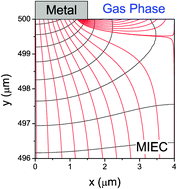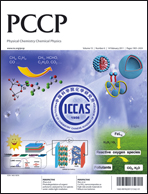A two-dimensional, small-bias model has been developed for describing transport through a mixed ionic and electronic conductor (MIEC) with electrochemically-active surfaces, a system of particular relevance to solid oxide fuel cells. Utilizing the h-adaptive finite-element method, we solve the electrochemical potential and flux for both ionic and electronic species in the MIEC, taking the transport properties of Sm0.15Ce0.85O1.925−δ (SDC15). In addition to the ionic flux that flows between the two sides of the cell, there are two types of electronic fluxes: (1) cross-plane current that flows in the same general direction as the ionic current, and (2) in-plane current that flows between the catalytically-active MIEC surface and the metal current collectors. From an evaluation of these fluxes, the macroscopic interfacial resistance is decomposed into an electrochemical reaction resistance and an electron diffusion-drift resistance, the latter associated with the in-plane electronic current. Analysis of the experimental data for the interfacial resistance for hydrogen electro-oxidation on SDC15 having either Pt or Au current collectors (W. Lai and S. M. Haile, J. Am. Ceram. Soc., 2005, 88, 2979–2997; W. C. Chueh, W. Lai and S. M. Haile, Solid State Ionics, 2008, 179, 1036–1041) indicates that surface reaction rather than electron migration is the overall rate-limiting step, and suggests furthermore that the surface reaction rate, which has not been directly measured in the literature, scales with  . The penetration depth for the in-plane electronic current is estimated at 0.6 μm for the experimental conditions of interest to SDC15, and is found to attain a value as high as 4 μm within the broader range of computational conditions.
. The penetration depth for the in-plane electronic current is estimated at 0.6 μm for the experimental conditions of interest to SDC15, and is found to attain a value as high as 4 μm within the broader range of computational conditions.
 . The penetration depth for the in-plane electronic current is estimated at 0.6 μm for the experimental conditions of interest to SDC15, and is found to attain a value as high as 4 μm within the broader range of computational conditions.
. The penetration depth for the in-plane electronic current is estimated at 0.6 μm for the experimental conditions of interest to SDC15, and is found to attain a value as high as 4 μm within the broader range of computational conditions.

 Please wait while we load your content...
Please wait while we load your content...